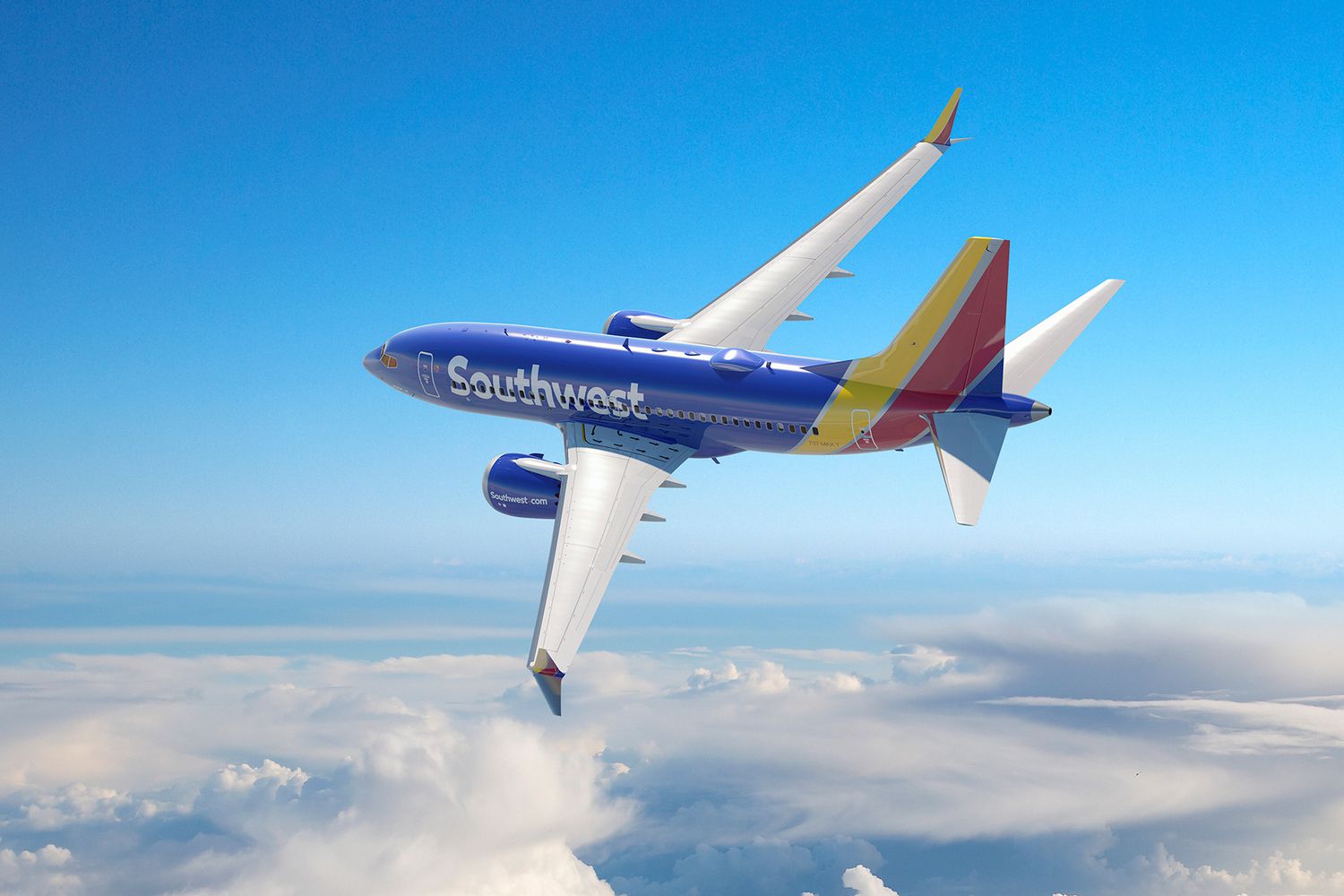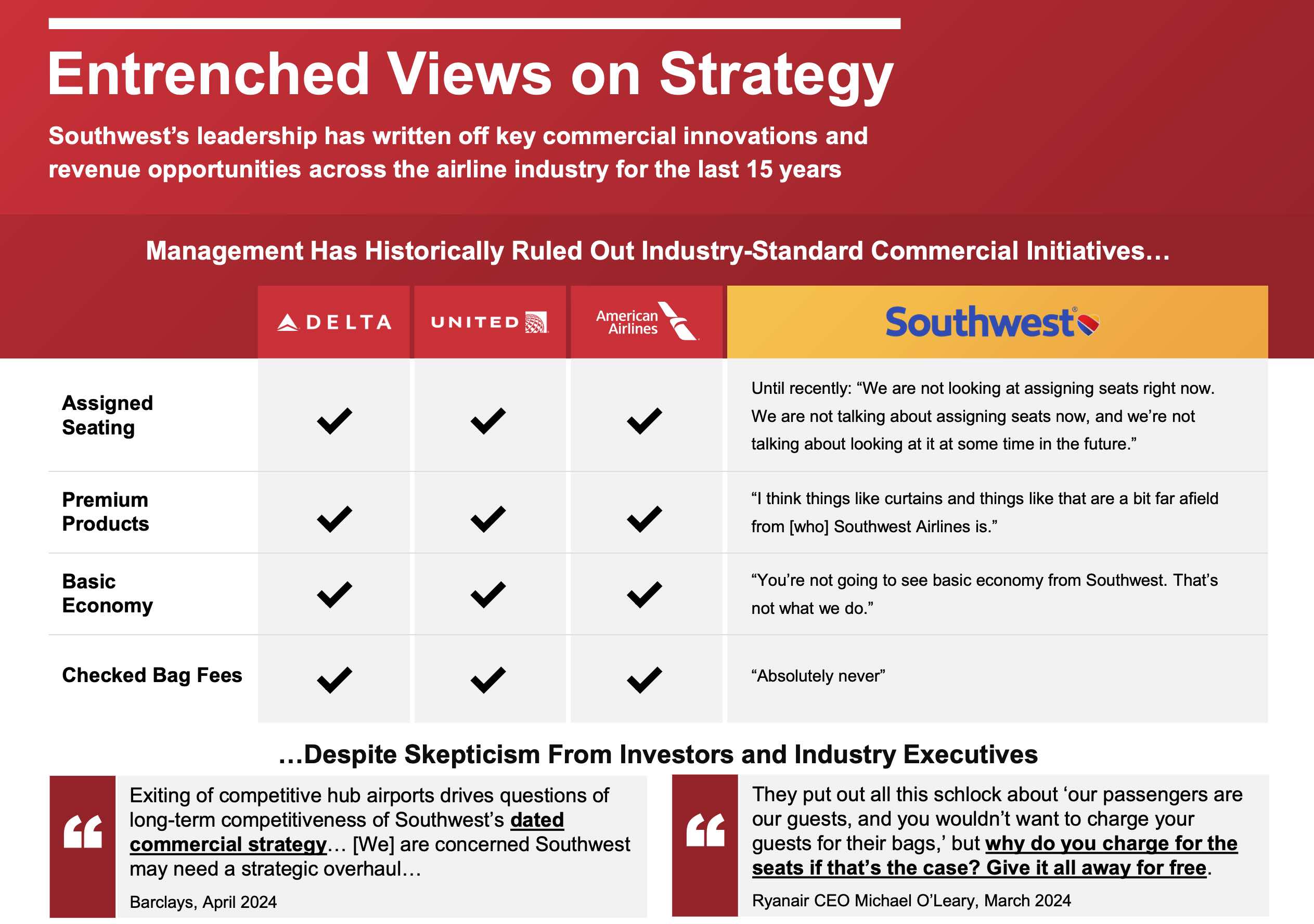
Southwest Airlines has been slow to evolve and frustratingly appears entrenched in a business model two decades past its prime. But a huge reason for the struggles at Southwest is the failure of Boeing to deliver aircraft on schedule. It’s time for Southwest to do a better job of reminding people of that.
Boeing Shares Blame For Southwest Airlines’ Woes
Yesterday, I wrote about the difficult position Southwest Airlines finds itself in. With high fixed costs but a route network limited by one aircraft model and compounded by delivery delays, the path to profitability is not straightforward.
Elliott Investment Management, a US investment firm, has invested $2 billion in the Dallas-based carriers with aspirational plans to turn the airline around and double its current stock price. Now, Elliott has released a slide deck (.pdf) outlining its thoughts on Southwest (thanks to View From The Wing for flagging this).
The 51-page slide deck is worth several minutes looking over, but what struck me was the lack of specific solutions and the rather foolhardy suggestion for immediate leadership change at the top.
Poor Load Factors Are Troubling, But Do Not Exist In A Vaccum
Elliott bemoans lower load factors on Southwest Airlines and points to particularly low load factors on inter-island flights in Hawaii. Yes, maybe Southwest Airlines should reconsider such service. But I also don’t see any analysis as to what impact those flights have on flights between Hawaii and the US Mainland. The idea that every route you fly has to be profitable is not sound logic when running an airline (case in point: United Airlines abandoning unprofitable New York JFK and losing out corporate travel on many other routes as a result).
Elliott Suggests Southwest Has Lost Out By Not Mimicking Legacy Carriers
Elliott points out that American Airlines, Delta Air Lines, and United Airlines offer:
- assigned seating
- premium products
- basic economy
- checked bag fees
…while Southwest does not. While stopping short of explicitly calling on Southwest to add these sources of ancillary revenue, it does fault management for having “historically ruled out industry-standard commercial initiatives despite skepticism from investors and industry executives.”

It calls initiatives portrayed as “transformative” really only “incremental” like Wi-Fi, in-seat power, and larger overhead bins onboard.
These initiatives do not deliver the strategic evolution required to remedy Southwest’s challenges. They are a normal part of running the business.
And they are also matched by all the carriers that Southwest is competing with.
But Southwest is unique among the four: it does not have widebody aircraft or a worldwide route network with joint venture partners to justify mimicking American, Delta, and United just because those three have found success in those four distinctions.
Call For Leadership Change
Elliott wants a revamped board of directors with independent voices + airline experience and new leadership within the company.

It’s calling for regime at the CEO and Executive Chairman level change without actually saying it directly:
Current Executive Chairman and CEO are rigidly committed to the status quo. Southwest must bring in new leadership from outside of the Company for Southwest’s strategy to evolve.
Southwest has responded to the suggestions with muted interest:
We are focused on restoring our industry-leading financial performance, the successful execution of our multi-faceted Tactical Action Plan to improve operational performance announced in first quarter 2023, alongside recent technology investments and operational resiliency programs that led to the operation of 99% of scheduled flights in first quarter 2024.
Our ongoing effort to optimize our network is addressing underperforming markets to better align capacity with observed passenger demand. We recently implemented a new revenue management system which, combined with our ongoing review of transformational initiatives, such as enhancing the Customer onboard experience, represent tangible steps toward achieving improvements in our financial and operational performance and positioning us for sustainable success in an evolving marketplace.
The Company looks forward to sharing additional detail on our plan at Investor Day in September.
In short: thanks, but no thanks.
Boeing’s Role In All This
Southwest has certainly erred. I don’t defend the business model in its current form nor do I excuse leadership for moving slowly to innovate on front- and back-end technology or failing to capture a strong market demand for a more premium product, even if that would just be extra legroom onboard (versus a first class cabin). These were missed opportunities and even today (wait till our Investor Day in September…) the carrier has been very slow in explaining its strategic vision for the company.
But let’s not forget Boeing’s role in all this. Southwest largely based its growth strategy–many years ago–on the delivery of Boeing 737 MAX 7 aircraft. In case you missed it, that aircraft is several years late and still has not been certified. It was also the aircraft well-suited for Southwest’s point-to-point route network versus the larger 737 MAX 8.
Look at this press release from 2021 that contains a chart of expected 737-7 deliveries starting in 2022. That never happened. Now Southwest Airlines is planning for a fleet that never has the 737 MAX 7.
While placing all your eggs in the same basket (here the 737 family) offers tremendous cost and operational advantages, it can also be very limiting as we see now.
It’s reasonable to say that Southwest would be in a very different and stronger position today if Boeing had delivered the aircraft it promised.
The Southwest Culture Is Unique…And An Asset
I don’t have much patience for the folks who insist that Southwest Airlines is the best airline in the world and swear by the carrier’s poky open seating policy or the necessity of two free checked bags.
But Southwest is special among unionized carriers in having a culture of pride in the carrier and (at least historically) its leadership. I realize some will argue that is just a facade, but I have flown Southwest enough over the years to recognize there is truth to that.
I quite agree with Cranky Flier that now is the time for Southwest to rally around it leadership, the very act of which might help the situation at Southwest. Labor unions are happy with new contracts so I see no holdouts that would cheer the bluster of Elliott; bluster that offers no viable solution beyond general suggestions and unhelpful platitudes.
CONCLUSION
While Southwest must avoid the Pan Am mentality that everything will eventually work out and ignore clear warning signs, I do think Boeing is a huge source of its problems. The carrier has already updated many systems after the late 2022 meltdown and should continue to evaluate the evolution of its product to include extra-legroom seating and assigned seating. Even so, the smartest path to growth for Southwest is simply to take delivery of the planes it has already ordered. Yet that is really up to Boeing, not Southwest…
> Read More:US Hedge Fund Wants To Transform Southwest Airlines
image: Southwest Airlines




“I don’t have much patience for the folks who insist that Southwest Airlines is the best airline in the world and swear by the carrier’s poky open seating policy or the necessity of two free checked bags.”
Pesonal opinion is personal opinion.
It’s true. But it’s also not an argument I am willing to engage in.
Agree. The Southwest cult can be INSUFFERABLE (even friends of mine). No need to even engage in that discussion, when they can’t be swayed that improvement is needed.
Most people in this country fly infrequently on routes such as CMH-MCO. They aren’t doing triple points transfers with an open leg to go half way around the world in business class. Southwest is a much better airlines for those people, hence why they are the largest domestic-not UAL, DAL, AAL.
I completely understand what your are arguing, and to a large extent I agree. However, Boeing’s troubles have majorly upset many airline’s plans and growth schedules beyond Southwest.
Southwest also shares much of the blame itself though. It’s tunnel vision insistence on only operating 737’s was understandable when it was starting out and attempting to succeed it a very competitive market. However, as the US’s largest airlines (at least by passenger numbers) it also bears a responsibility in my opinion to drive the commercial aviation market forward. Telling your only supplier you want to buy nothing but a nearly 60 year old aircraft design is not one of the ways you drive the industry. I also suspect that Southwest’s fingerprints are all over behind the scenes of Boeing’s totally brain-dead idea to even attempt to do the MAX program.
Driving your only supplier, which you are 100% dependent on, into a decision that in hindsight put the very future of Boeing even being able to continue as a viable business is not too smart in my book.
Yes, this is it exactly:
“Southwest’s fingerprints are all over behind the scenes of Boeing’s totally brain-dead idea to even attempt to do the MAX program.”
Everything I’ve read on the MAX disaster has cited Southwest’s insistence that they would not support any new plane from Boeing that required pilot retraining as a primary factor in Boeing’s ill-fated decision to build the jerry-rigged MAX instead of a brand-new plane. Not sure whether Southwest’s ultimatum or Boeing giving in to it was worse.
I really think that is passing the buck.
If Boeing was too desperate or greedy to say no, that is on them.
The Southwest ask was not unreasonable and they were certainly not told their requirements were unreasonable.
Southwest just isn’t very appealing to a certain customer demographic that likes premium service. They need to go back to the drawing board and understand what makes them popular amongst certain consumers and how to develop that further.
Southwest not even being on Google Flights until recently probably was also a huge hit.
How do Boeing delivery delays have anything to do with this? WNs -700s are all 12-19 years old, even the oldest have years left in them. (If they run them like the Legacies, close to 10!). Flights massive amounts of horribly performing routes, including their lackluster 5 AM departures all over their network. IMO, the delivery delays are a huge tailwind for WN, as they don’t have anywhere to fly those planes profitably (other than maybe some routes that would become profitable with a more fuel efficient plane). WN has been hitting near double digit capacity growth for a while now, they have no plane issue, they have a Revenue issue… they cant get enough people to buy their tickets. Hence why they now sell on Google Flights and the GDS
MAX 7 (737-7), not 737-700.
Southwest runs a very different operation and very different customers to begin with. Comparing this to AA, UA and DL is just silly and shows that Elliott has probably no real understanding of what they´re asking for.
You are correct, Matthew. The root of WN’s problems can be laid at Boeing’s feet and their inability to certify the MAX 7 and deliver even MAX 8s which WN has said are too large for many of WN’s route network as a heavily point to point carrier. AA, DL and UA all had A321NEOs and other models on order but low cost carriers are built around simpler fleet and high rates of growth; WN has been hamstrung in being able to grow for more than 5 years. If WN knew 5 years ago that Boeing would still not have the MAX 7 certified 5 years after it was promised and counting, they would have taken other steps. WN has repeatedly revised down its expected vs. contractual deliveries. Their strategies are now in response to the reality that they won’t get significant numbers of new aircraft for several more years. If Elliott really wants to make an impact, take on Boeing and they will benefit far more airlines and airline stocks than just Southwest. Yes, WN underinvested in technology but they have been pushing their fleet and their schedule far harder than they would if they had more planes available.
And let’s not forget that Icahn created a lot of fear when he announced his equity in JBLU and yet he has done very little in part because JBLU had a turnaround plan. LUV already was working on a plan and I would bet that Elliott will pocket some cash from the rise of LUV stock which they helped make happen but which is not likely to significantly change the strategy that WN already intended to do.
Did you really read the Elliott Presentation, slide 36? For some inexplicable reason Southwest is clinging to low load factor routes that their competitors don’t. A full 12% of Southwest’s routes have a load factor below 70%, vs. 3% at American and 1% at United and Delta. Even horribly run American has only 3% of routes with load factors under 70%. I can see Southwest having maybe 5% of routes with sub 70% load factors due their route structure and only having 2 sized aircraft, but 12%?? C’mon man, that is horrible management. It would appear Southwest has plenty of aircraft available if they would just stop flying over 10% of their fleet around half empty.
SW is in its Senior year. Yet, it acts like a first semester Freshman ignoring his assignments.
Spirit and Frontier have gotten religion as of late and realize their business model needs reform.
JetBlue experienced its epiphany and is cleaning up its act on connections, codeshare, and completion of flights.
AA knows disaster awaits if it continues to treat FA’s as the adversary as opposed to the ally.
Other airlines have the P&W turbo gear issue, but survive.
Other airlines suffer from the MAX issue, but they continue to function.
However, Southwest continues to ignore the writing on the wall.
It set itself up for the private equity intrusion. Now, its crying in its soup.
Sorry, no empathy for SW….time to grow up!!
You are your own worst enemy!!
I will consider this a NORMAL airline only if they start assigning seats!